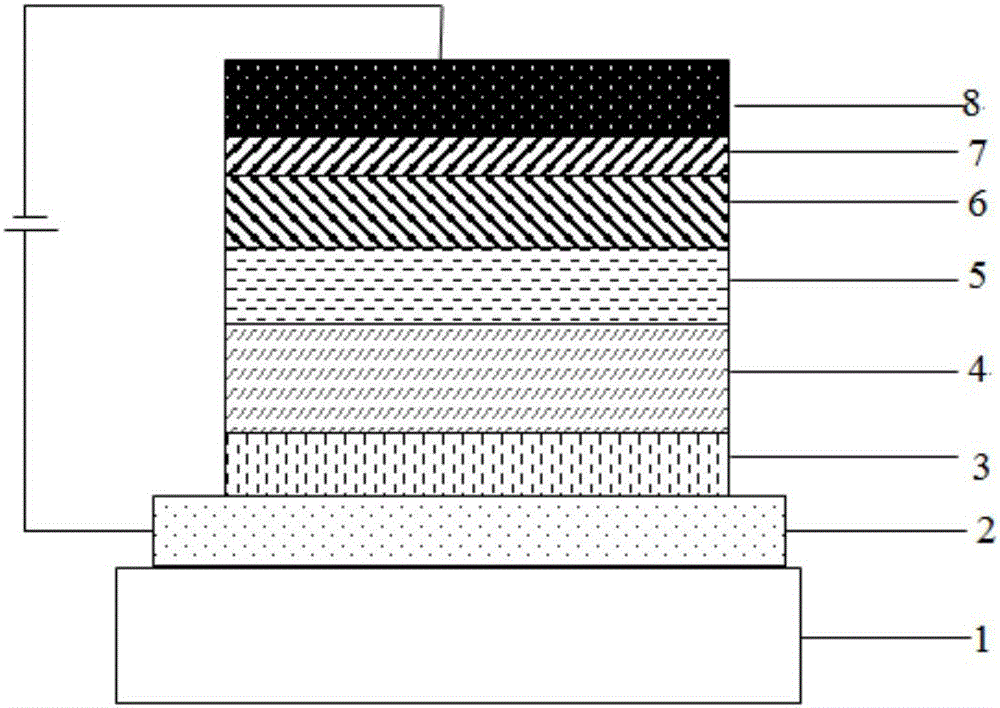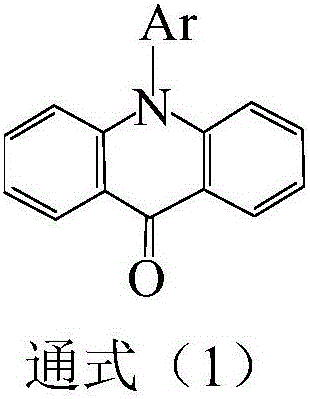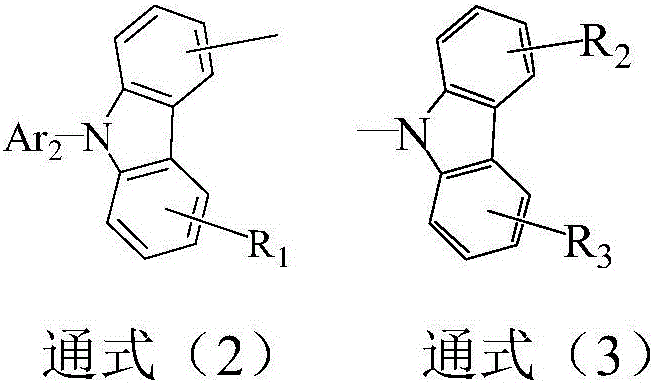Compound with acridone as core and application of compound to organic electroluminescent device
A technology of light-emitting devices and compounds, applied in the fields of electrical solid devices, electrical components, light-emitting materials, etc., can solve the problems of efficiency roll-off, difficult exciton utilization rate, high fluorescence radiation efficiency, and low S1 state radiation transition rate, etc. The effect of increasing orbital overlap, good fluorescence quantum efficiency, and good industrialization prospects
- Summary
- Abstract
- Description
- Claims
- Application Information
AI Technical Summary
Problems solved by technology
Method used
Image
Examples
Embodiment 1
[0039] The synthesis of embodiment 1 compound 2
[0040]
[0041] The concrete synthetic route of this compound is provided now:
[0042]
[0043] In a 250ml four-neck flask, under nitrogen atmosphere, add 0.01mol 3-bromo-9-(3,5-dimethylphenyl)-6-(diphenylamino)carbazole, 0.025mol acridone , 0.03mol sodium tert-butoxide, 1×10 -4 mol Pd 2 (dba) 3 , 1×10 -4 mol tri-tert-butylphosphine, 150ml toluene, heated to reflux for 24 hours, sampled and spotted, the reaction was complete, naturally cooled, filtered, the filtrate was rotary evaporated, and passed through a silica gel column to obtain the target product with a purity of 99.60% and a yield of 57.32%.
[0044] Using DEI-MS to identify the compound, formula C 45 h33 N 3 O, detection value [M+1] + =631.42, calculated value 631.26.
Embodiment 2
[0045] The synthesis of embodiment 2 compound 4
[0046]
[0047] The concrete synthetic route of this compound is provided now:
[0048]
[0049] In a 250ml four-neck flask, under an atmosphere of nitrogen gas, add 0.01mol 3-bromo-9-(3,5-diphenylphenyl)-6-tert-butylcarbazole, 0.025mol acridone, 0.03 mol sodium tert-butoxide, 1×10 -4 mol Pd 2 (dba) 3 , 1×10 -4 mol of tri-tert-butylphosphine, 150ml of toluene, heated to reflux for 24 hours, sampling plate, reaction complete, natural cooling, filtration, filtrate rotary evaporation, silica gel column to obtain the target product with a purity of 99.62% and a yield of 62.32%.
[0050] Using DEI-MS to identify the compound, formula C 47 h 36 N 2 O, detection value [M+1] + =644.52, calculated value 644.28.
Embodiment 3
[0051] The synthesis of embodiment 3 compound 7
[0052]
[0053] The concrete synthetic route of this compound is provided now:
[0054]
[0055] In a 250ml four-neck flask, under nitrogen atmosphere, add 0.01mol 3-bromo-9-phenyl-6-acridylcarbazole, 0.025mol acridone, 0.03mol sodium tert-butoxide, 1×10 -4 mol Pd 2 (dba) 3 , 1×10 -4 mol tri-tert-butylphosphine, 150ml toluene, heated to reflux for 24 hours, sampling plate, reaction complete, natural cooling, filtration, filtrate rotary evaporation, silica gel column, to obtain the target product with a purity of 99.52% and a yield of 64.42%.
[0056] Using DEI-MS to identify the compound, formula C 46 h 33 N 3 O, detection value [M+1] + =643.58, calculated value 643.26.
PUM
| Property | Measurement | Unit |
|---|---|---|
| thickness | aaaaa | aaaaa |
| thickness | aaaaa | aaaaa |
| thickness | aaaaa | aaaaa |
Abstract
Description
Claims
Application Information
 Login to View More
Login to View More - R&D
- Intellectual Property
- Life Sciences
- Materials
- Tech Scout
- Unparalleled Data Quality
- Higher Quality Content
- 60% Fewer Hallucinations
Browse by: Latest US Patents, China's latest patents, Technical Efficacy Thesaurus, Application Domain, Technology Topic, Popular Technical Reports.
© 2025 PatSnap. All rights reserved.Legal|Privacy policy|Modern Slavery Act Transparency Statement|Sitemap|About US| Contact US: help@patsnap.com



